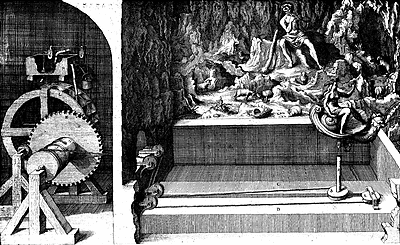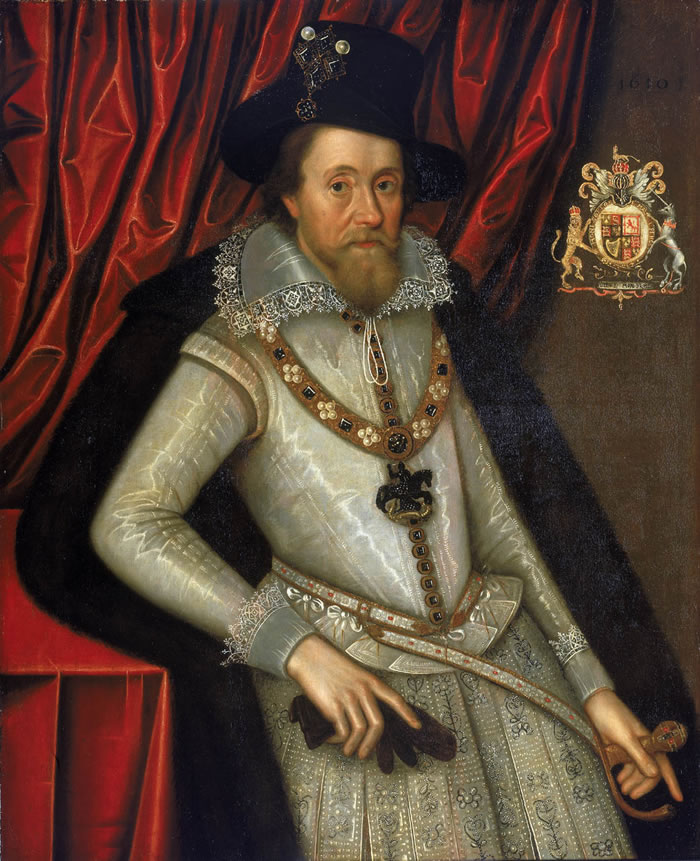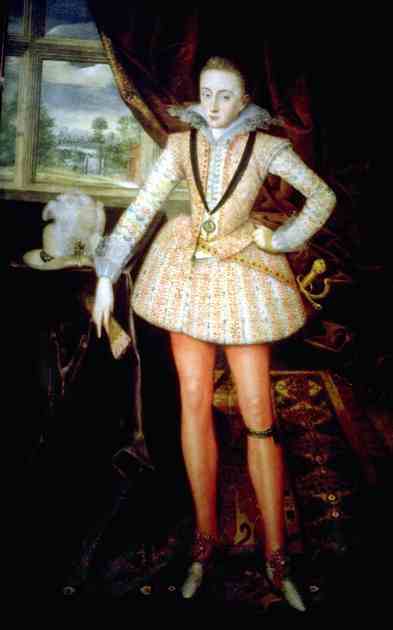Henry, Prince of Wales (1594-1616)
Henry Frederick Stuart was born on February 19, 1594 in Scotland and was the first child of King James VI of Scotland (later King James I of England) and Anne of Denmark. He was groomed for kingship from the beginning and was created Prince of Wales at Westminster in June 1610. He was intelligent, well read, an excellent swordsman, an avid patron of the arts, obsessed with war and military weapons and possessed of a strict sense of morality. He was also a stout Protestant and was very approving of his sister Elizabeth’s proposed match to the Protestant Frederick, Elector Palatine.In November, 1612, Henry suddenly took ill and died, probably of typhoid fever.
Although his court only lasted two years its impact was significant. His court was based in St. James (as the Prince of Wales court still is today) and at Richmond Palace (built by Henry VII) at Richmond. The first thing Henry did was to try to modernise and transform Richmond Palace although all his grand projects tended to run out of money. He was a major international figure despite his young age and impressed the ambassadors that met him. His advisors were sophisticated staunch Protestants and he was regarded by everyone as remarkably bright and mature. We are fairly certain of this as it was a common opinion held even by his potential detractors.
His advisors travelled extensively throughout Europe and wrote long, detailed letters back to him about the courts of Europe. All foreign travel required royal approval and in Elizabeth’s reign very few travelled abroad as foreign travel was effectively banned. Under James’ rule this was relaxed and James signed a peace accord with the Spanish in 1604. This resulted in an exchange of ambassadors with many countries, including Venice which was important for art collectors.
Sir John Holles (Comptroller of the Household) was a close advisor and owned a copy of Palladio (an early instance of the book in England), Alberti (Lives of the Artists, 1568) and Hans Dieterlin, a German designer. Sir John Danvers introduced the fashion for elaborate Italian gardens. Many of his advisors travelled to France and to Florence and wrote about what modern, up-to-date courts were doing.
Peter the Great, the great Russian reformer, about 100 years later had similar plans for his court. They both wanted to learn from other courts in Europe and bring their country up-to-date with the latest fashions.
Henry was a good horseman and introduced the horse riding style taught at the Vienna School (Spanish Riding School). The style began in Italy but became the latest fashion throughout Europe.
Henry wrote to the King of France for assistance and was sent Monsieur de Saint Antoine, the second greatest horseman in France. He remained in England and was the equerry for Charles I 30 years later in the painting of Charles I.
[Charles I on horseback]
Henry’s riding school became the standard finishing school for young gentlemen. There had been an extraordinary interchange of horses across Europe for the previous 100 years. The young MP George Trenchard got badly into debt building a replica of the Prince’s riding stable at his homeat Wolfeton, Charminster, Dorset, and the stable still stands.
The courts of Prague and the Medici were the two that Henry had his eye on as leading courtly fashion.

Henry, Prince of Wales, Marcus Gheeraerts the Younger, circa 1603
At the Medici court Bernardo Buontalenti was the great polymath – designer of churches and palaces, painter, designer of entertainments for the Grand Duke of Tuscany and he served in this position for 30 years.
Tudor gardens were flat and formal with few plants. They often contained coats of arms on poles positioned regularly around the space.
The garden of the Medici court was at Pratolino and it was famous across Europe and became the model for leading court gardens. Gardens are interesting as they show broader aspects of the culture. Vast sums were spent on them in order to demonstrate wealth and show of their intellectual understanding. Gardens had automata driven by machinery and water based on the automata in Greek stories. They also had spectacular hydraulic display with cascades and fountains. A garden referred to Arcadian myths and classical pastoral stories. Rustics, such as hermits, could be introduced in a playful way. Marie Antoinette had a Disney-like cottage with milking parlour and although this was much later it was part of the same cultural reference to the classical pastoral.
Works of art and gardens were full of symbolic and allegorical meaning. The above page from the emblem book by Geffrey Whitney: “A choice of emblemes, and other devises” (see http://emblem.libraries.psu.edu/home.htm for a number of scanned emblem books). In this case the snake twisting round a flower is a metaphor for the moral “beware of false flattery”. Whole collections of plants and plant display had complex symbolic meaning.
In a broad sense an ordered garden represented an ordered universe and this signified that everyone knew their place in the universe and the absolute monarch was on top of everyone. This broad symbolic meaning of an ordered garden was one reason they were favoured by monarchs.
Henry needed to bring in foreign expertise to achieve his ambitions. The three key figures were:
- Constantino de Servi
- Salomon de Caus
- Inigo Jones
de Servi (pronounced “Sevi”)
Stayed for five years working at Richmond (although Henry originally wanted someone else). He trained in Florence and knew Bountalenti. Henry wanted him to create gardens and garden features such as grottoes and statues. He was initially a painter but none of his paintings survive. We know he painted Henry’s mother Anne of Denmark. de Servi designed buildings but as the money was always running out he constantly complained in his letters about how poor the English court was compared to other courts in Europe.
The statue of “Dio Appennino” of Giambologna in Medici’s Park, of Pratolino was the greatest sculpture of the late sixteenth century. Henry planned a statue three times larger with rooms inside and a dovecote in the head and two grottoes in the base. De Servi complained in his letters that the way the English created their buildings was a complete mess as there was no single person inoverall charge. He introduced the foreign idea of such a person, the architect. We know from his letters that he wrote to FLorence asking for designs.
de Caus (pronounced “do Ko”)
De Caus was French and was already in England. He had travelled in Italy and head seen the Pratolino. Henry idealised Henry IV of France. Initially de Caus worked for the Queen and some of his designs survive.
Apollo and the Muses on the top of Parnassus. It is a copy of a fountain at Pratolino and was built at Somerset House for the Queen. He also worked at Greenwich. HE was paid double what Inigo Jones was paid but half what de Servio was paid.
He was able to produce correct perspective and he wrote a book on perspective and claims to have taught Henry about perspective. He started Henry’s garden at Richmond.
Nymph playing a hydraulic organ and a grotto with the Triumph of Neptune (see designs for de Servio’s Orpheus grotto). There is an eighteenth century grotto remaining at Woburn which gives some idea of what these seventeenth century grottos looked like.
His other design was a 55 foot high rectangular hill with windows like eyes. A walkway with a statue at the top.
Inigo Jones made no impression at all at the time. De Caus and de Servi’s letters show that it was a bear pit of back biting and intrigue. De Servi was the worst – an arrogant, obnoxious, prima donna. He referred to de Cau as “that Frenchman”. Inigo Jones had not built a single building when he entered Henry’s service. He was simply the Surveyor, not an architect. When Henry died he went back to Italy for a second time.
Henry’s Policy of Painting
The Jacobena court was dominated by de Critz and Gheeraerts.
Portrait by Gheeraerts of Henry commissioned by Henry Lee.
Portrait of James I by John de Critz – showing him as a very pedestrian painter, James is stiff and wooden.
Portraiture became increasingly important particularly for monarchs. It is intended to express the mythology around the monarch not just provide a physical impression (van Dyck is the ultimate expert at this). Henry appoints Robert Peake.
Henry, Prince of Wales by Robert Peake. Peake was Sergeant Painter to James I. John de Critz and Robert Peake were neighbours. Peake was appointed as Henry’s Picture Maker and we don’t know why. The above picture shows Henry out hunting with John Harrington (1603 now in the Metropolitan New York). The pose comes from Holbein’s image of HEnry VIII and Edward VII (who came to the throne aged 9) is also shown in this legs apart pose. The picture has a sense of movement and dynamism. There is a deep landscape background that was introduced by Gheeraerts. This picture is unprecedented for a royal portrait in showing a monarch outside.
Henry Prince of Wales, Robert Peake.
(Picture not found – Henry’s sister Elizabeth with two figures in the background climbing a hill, 1603, by Robert Peake, her age 7 is on the fan).
Had Henry known Robert Peake a long time before appointing him? And why did he appoint him as his style is backward, in the Hilliard tradition and Henry was loooking for the latest fashions in Europe.
Hilliard, Percy Cecil, 1590. Note the philosophic thinker deep in thought with his book and the cannon ball balanced in the tree against a feather.
Parum Park Sussex. Peake’s portrait of Henry on a white horse with a fleur de lys above was restored in the late 1980s by Hamilton Carr Institute. The background had been overpainted in the late seventeenth century and it was removed to reveal a wall and the the figure of Time or Opportunity – a naked figure with wings. He has a long forelock fixed to Henry’s shoulder so Henry is “taking opportunity by the forelock” (a saying at the time). The horse was also touched up to look more sculpted and to remove the staring eye.
It was made to look more like the horse in van Dyck’s Charles Iportrait. In other words in the late seventeenth century they tried to “van Dyck” the background.
Peake painted the young Charles I as a commission for Cambridge to celebrate a visit and the painting is still at Cambridge.
In 1611 Peake translated Serlio’s book and dedicated it to Henry. There is an original 1611 copy in the Warburg Institute.
Henry approached Miereveld (Pronounced “Mirrorvelt”).
Michiel Janz. van Mierevelt, Fredrick V, Elector of the Palatinate, c. 1628-32
(Not found – Miereveld Portrait of Sir Edward Cecil.)
He was a very up-to-date and sophisticated artist, note the plasticity of the head.
Isaac Oliver was also brought to his court and made his Painter but his Limner was Mr Bilford who we no little about as none of his works survive..
Isaac Oliver, Henry, Prince of Wales. Note the tents and the armour, this is presenting Henry as a medieval knight with its associations of chasteness (unlike his father!) and chivalry.














